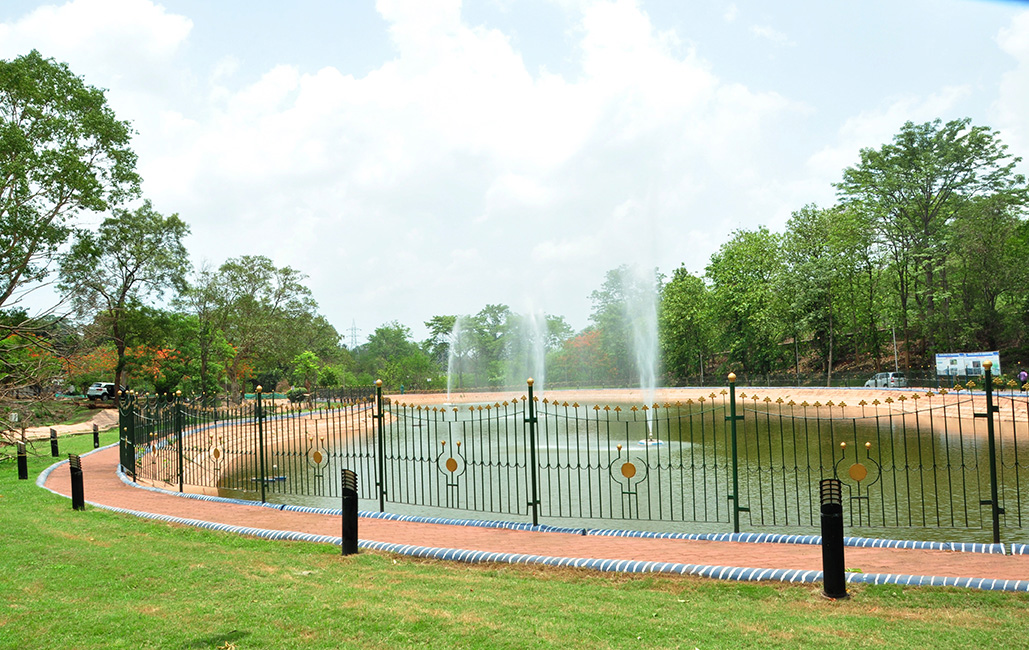Water Recycling and Harvesting at OMQ Division

Mining is a water intensive industry and apart from extracting minerals from the earth, water is another critical resource that is consumed immensely in the operations.
Tata Steel has four mines in its OMQ division in Jharkhand and Odisha which are ISO certified.
Most of the mines are also accorded ‘Five Star rating’ for its sustainable mining practices by Ministry of Mines, Govt. of India.
Over the recent years, the importance of water conversation has spiked and we have been conscious of this phenomenon. We continuously strive to conserve water smartly, while reducing the environmental footprint of our processes through various methods such as awareness generation, technological intervention, research projects, policy review and community development.
Initiatives for Water Recycling:
Increasing industrialisation, escalating agricultural requirementse growing population have stressed upon the need for saving every drop. Through some of our following initiatives, we promote and support water recycling.:
- Sewage Treatment Plant (STP)
- High Rate Thickener
- Recovery of Clear Water from Slime
- Leak Detection and Monitoring
Sewage Treatment Plant (STP)
To attain zero discharge, we have deployed STPs in our township and a few residential areas. In Noamundi and Joda, we have connected all the sewage lines with our modern and advanced STPs. For theareas are not yet connected to the main sewage lines, we have the conventional septic tank and soak pit.
Other than the five STPs at Joda, another facility is under-construction. Ourhospitals, at Noamundi and Joda, have several dedicated STPs to recycle and reuse waste-water efficiently, and the water generated thereafter is used for gardening and other purposes.
1. High Rate Thickener
High Rate Thickeners have been installed in the Wet Processing Circuit ofour mining premises of Joda and Noamundi. They are equipped to extract the major portion of suspended solids from the water. The clear water that flows from the thickener is pumped back for recirculation and washing purposes. This, in turn, significantly reduces the consumption of fresh water.
To increase the efficiency of the thickener, we have replaced the conventional thickener with a state-of-art HRT (High Rate Thickener) technology, which has resulted in reduction of Specific Water Consumption from 0.32L/T to 0.20L/T. Our Water Recovery has witnessed a spike from 65% to 85%. Also, the quantity of water discharged with the slime has reduced by 23%.
2. Recovery of Clear Water from Slime
Using select chemicals at the slurry disposal point in the slime dam, we create better compaction that helps us release a greater quantity of clear water. This water is then pumped back to the mines and is used for various mining purposes.
3. Leak Detection and Monitoring
To prevent leaks, we we deployed flow meters at various checkpoints in our processing plants. These flowmeters are equipped to measure, meter, control, and monitor the water flow better. These actionable insights have helped us make better decisions.
Initiatives for Water Conservation and Harvesting:
1. Rainwater Harvesting Projects:
To recharge the groundwater table during the monsoon season, we constructed constructed special rainwater harvesting structures. This is a part of our plans to convert a portion of the mined-out pits in each mine into water harvesting structures. Fouroperational water harvesting structures are being constructed at Noamundi and two at Joda.
After successfully implementing rainwater harvesting projects across our sites, we observed that many springs had developed in the surrounding areas, resulting in a heavy flow of water through drains to the downstream area As a result of our effort, there has been a steady rise in the groundwater table (4-5 ft increase in groundwater level) at the project site and downstream side. It supplemented minor irrigation purposes.
Dust suppression during summer was increasingly becoming difficult due to the shortage of water. But with Rainwater Harvesting Project, the problem was solved.
With the implementation of these rainwater harvesting projects, the depletion of the groundwater table in the mine area and the downstream area of the mine has been arrested gradually. The bore-wells, open-wells, and hand pumps operating in the community, particularly in the downstream areas of the mine, are benefiting from these projects. The extraction of water from the recovery wells has not only increased but also become sustainable.
The overall quality of the groundwater, particularly water extracted from the wells, has improved along with a reduction in the dissolved solids in the water. The moisture content of the top soil in the vadose zone has increased significantly. This also has given rise to a vigorous growth of trees and plants in the areas around the built structures. Moreover, this has helped us save power as the need to pump water from the river source has gone down.
2. Water Conservation by Recycling
Tailings generated from the processing of ore (not discharged outside) is stored in zero discharged slime ponds in the mining lease area. The tailings are diverted to the thickener where the suspended solids settle down and the decanted water is recycled back for use in the process.
The cycle continues and results in minimum requirement of fresh water.
Water conservation and best usage practices at OMQ has led to a continuous decrease in the per capita water consumption.
It has decreased from 204 lt/person/day in 2014-105 to 192lt/person/day at present with the help of different enablers.
Other Water Conservation Initiatives include:
- Channelisation of surface run-off by the network of toe-wall and garland drains around OB? and waste dumps to the settling pit and slime dam.
- Plantation on slopes of dump yards to stabilise dumps and increase green cover inside mines.
- Collection of rainwater at the lowest bench of pit during the monsoon.
- Construction of a series of check dams across the water courses that enable retention of suspended solids and allow flow of clear water during rainy season.
- Sedimentation pits have been constructed at the corners of the garland drains to take care of runoff of water during peak rainfall which are de-silted regularly before and after the monsoon.









